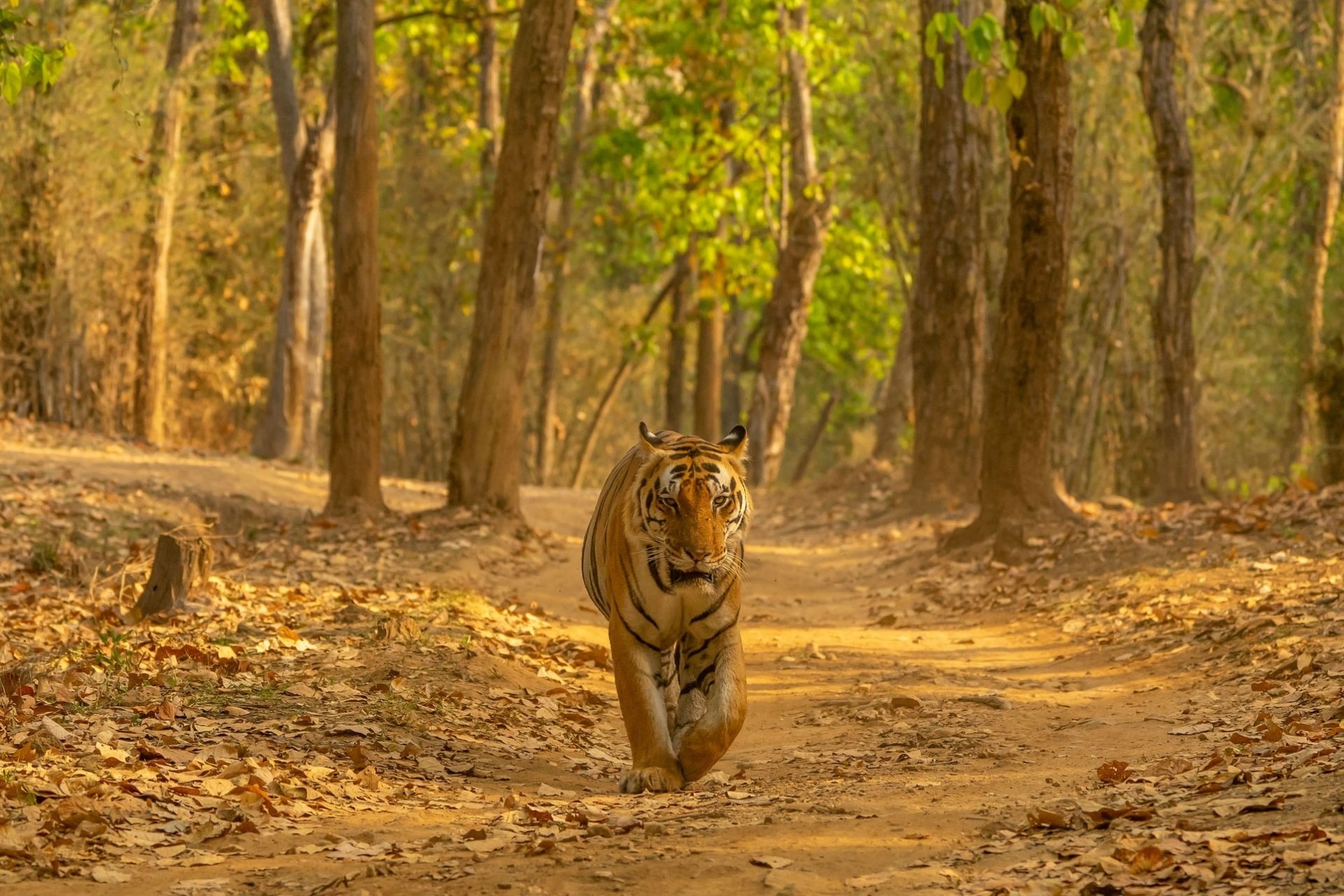Have you ever gone for a wildlife road trip and come back without seeing any wild animals, especially tigers? That churning feeling in your gut is so painful, you feel like being more prepared the next time around. But you never know when that will happen.
For those of you looking for the best tiger reserve in India, you have come to the right place to hunt for one.
With breath-taking sights, abundant flora and fauna coupled with the interesting safari options, you can be sure of one hell of a ride through the forests of India.
Make your holiday as blissful and adventurous as you want. Get your adventure gear ready, put on some sunscreen, pack your camera and let’s go have a ‘roaring’ time at the top 26 Tiger Reserves in India.
1. Sariska Tiger Reserve
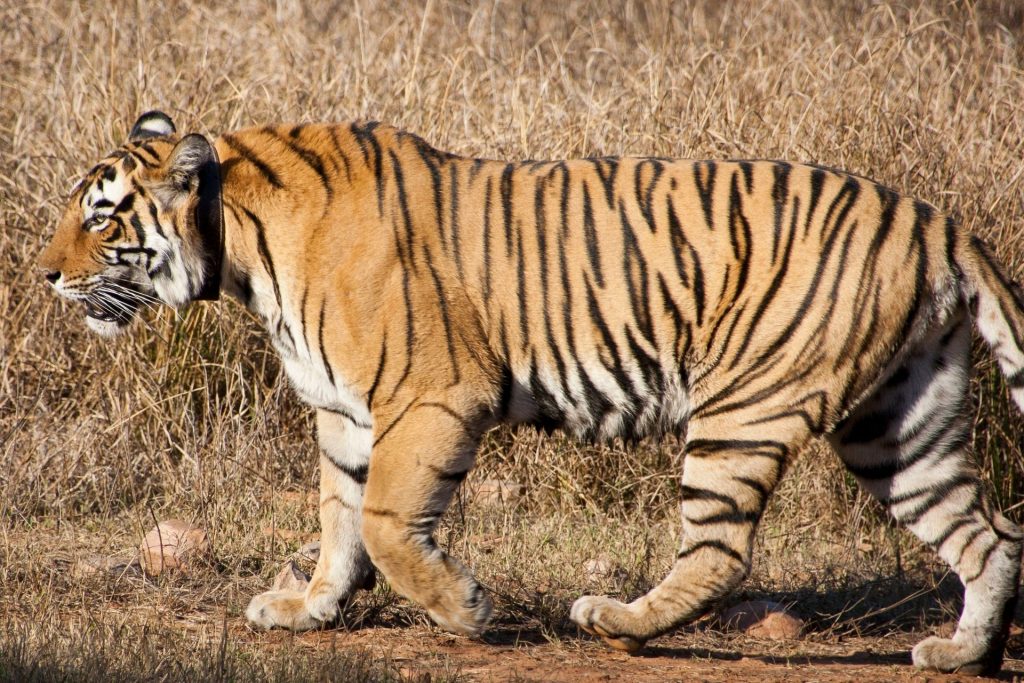
Located in Alwar district of Rajasthan, Sariska Tiger Reserve is one of the most sought after tiger sighting reserves. The forest is mainly made up of dry deciduous forests, scrub-thorn arid forest, rocky hills and grasslands.
#Trivia: It was the erstwhile hunting area of the Alwar state and, after much deliberation, was declared a wildlife preserve in 1955. It acquired the status of a tiger preserve in 1978 and was declared a National Park in 1990.
As of 2018, there are 18 tigers including 5 tiger cubs in the National Park. Sariska is home to a number of wonderful wildlife species, including Hyenas, Jackals, Wild Dog, Jungle Cat, Leopards, Indian Horned Owl, Chital, Rhesus Monkeys, Tree Pie, Crested Serpent Eagle, Golden-backed Woodpecker, and much more.
Each of these wildlife creatures can be enjoyed with the help of a guided tour package that is offered at the National Park throughout the year, including wet seasons of July to September.
Penetrate the forests of Sariska with Jeeps or Canters or even Elephant backs, to enjoy the gorgeous sights of the forest.
Safari Timings of Sariska Tiger Reserve
During Winter the safari timings at Sariska Tiger Reserve is from 6:30 AM to 10:30 AM and in the Evening from 2:00 PM to 6:00 PM.
During Summer the safari timings at Sariska Tiger Reserve is from 6:00 AM to 10:00 AM and in the Evening from 2:30 PM to 6:30 PM.
Entry Fee of Sariska Tiger Reserve
Entry fee to Sariska Tiger Reserve for Indians is INR 80 per person. For Foreigners the fee is INR 470 per person. For those who wish to carry a Video Camera the fee is INR 400.
Spot a tiger, explore the forts and ruins of havelis inside the forest or pay a visit to the glorious ancient Hanuman temple, to thoroughly enjoy your trip to Sariska!
2. Bandipur Tiger Reserve

A glorious lush green forest set amidst the Nilgiris, the Bandipur Tiger Reserve is absolutely a must visit holiday-cum-adventure destination. Bandipur National park is an iconic tourist destination amongst all those visiting Karnataka.
Once the hunting grounds and a private reserve for the Maharaja of the Kingdom of Mysore, Bandipur Tiger Reserve is now a protected National Park with a variety of biomes and abundant wildlife.
The reserve is enriched with gorgeous flora and fauna that forms an important part of the biosphere of the forest and surroundings areas. The Tiger reserve was formally brought under the Tiger Project in India in the year 1973 and till date remains a favourite tiger spotting forest amongst adventure-lovers.
#Trivia: The tiger population is at an all-time high in the world comprising a glorious 382 majestic beings roaming the lands of Bandipur.
The Bandipur Tiger Reserve, along with Nagarahole, Sathyamangalam, Mudumalai, Wayanad Landscape is the major source of faunal population in the Western Ghats of the country. All these National Parks comprise the Nilgiri Biosphere Reserve.
Besides Tiger you can also spot different fauna such as gaurs, sloth bears, muggers, four-horned antelopes, Indian elephants, Indian rock python, dholes, jackals, chitals, Grey langur, sambar, muntjac, wild boar and much more.
You can also regale the sight of
#Trivia: It has the largest wild elephant population in South Asia. It holds nearly 150 cattle.
Best Time to Visit Bandipur Tiger Reserve
Best time to visit this tiger reserve is summer, between October and May. You can choose to go on a bus or jeep or elephant safari depending on your requirement. If you are travelling in a large group, hiring a bus makes sense. In groups of 4, you can choose to take a jeep safari and to explore the deeper parts of the forest, taking an elephant safari is a great way to spot animals.
Timings of Bandipur Tiger Reserve
Bandipur Tiger Reserve is open from 6:00 AM to 6:00 PM. It is open on all days of the week.
Bus safari timings: 6:30 AM to 9:00 AM and 3:30 PM to 5:30 PM.
Elephant safari: 10:00 AM to 11:00 AM.
Jeep Safari: 6:00 AM to 9:00 AM and 4:00 PM to 6:00 PM.
Entry Fee of Bandipur Tiger Reserve
Entry fee to Bandipur Tiger Reserve for Indians is INR 300 per person. For Foreigners the fee is INR 1100 per person. For those who wish to carry a Video Camera the fee is INR 200.
Gear up for a safari through the most exciting forest trail in India, Bandipur Tiger Reserve! Book your tour package today!
3. Jim Corbett National Park
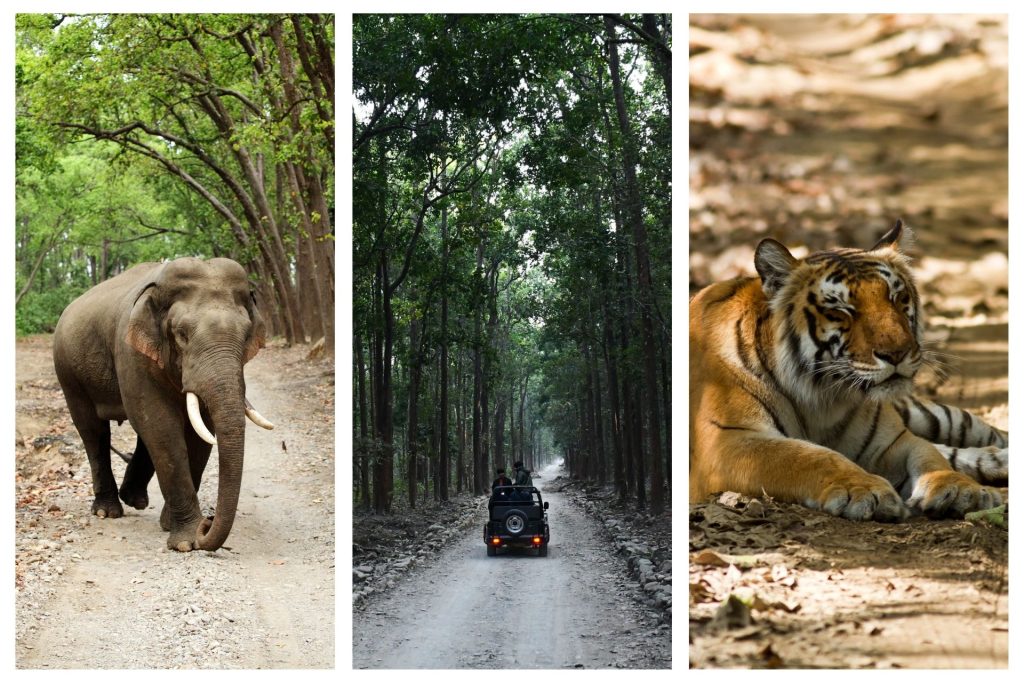
One of the oldest tiger reserves in the country, Jim Corbett Tiger Reserve is by far the most popular tiger sanctuary and national park located in Nainital District, Uttarakhand. Established in 1936 as Hailey National Park, it is home to the critically endangered species of Royal Bengal Tigers. With an expansive terrain covering acres of land and comprising nearly 5 zones to enter the park, Jim Corbett is a haven for wildlife enthusiasts.
#Trivia: It is the first place where Project Tiger was launched in the country in 1973. It is said to have a staggering 215 tigers living here! The highest in the country.
A jungle safari through the wilderness of Jim Corbett will take you up close to see a variety of animals such as sambar deer, herd of Asiatic elephants crossing the road, prancing peacocks, jackals, foxes, critically endangered species of Gharial, Asiatic black bear, walking deer, hog deer, and over 600 species of birds, amongst others.
It is also home to the mugger crocodiles and king cobra along with other endangered reptiles.
#Trivia: It is one of the few national parks in the country to allow night stay inside the premises of the park at different tourist houses located within.
Best Time to Visit Jim Corbett Tiger Reserve
Best time to visit Jim Corbett is from October to June when you can spot animals roaming around freely. Although it is better to travel around February to April when the animals come out to their watering holes.
Timings of Jim Corbett Tiger Reserve
During Winter the safari timings at Jim Corbett Tiger Reserve is from 7:00 AM to 10:30 AM and in the Evening from 2:00 PM to 5:30 PM.
During Summer the safari timings at Jim Corbett Tiger Reserve is from 6:00 AM to 09:30 AM and in the Evening from 3:00 PM to 6:30 PM.
Entry Fee of Jim Corbett Tiger Reserve
Entry fee to Jim Corbett Tiger Reserve for Indians is INR 1500 to 4500 per person. For Foreigners the fee is INR 3000 to 6000 per person.
4. Periyar Tiger Reserve
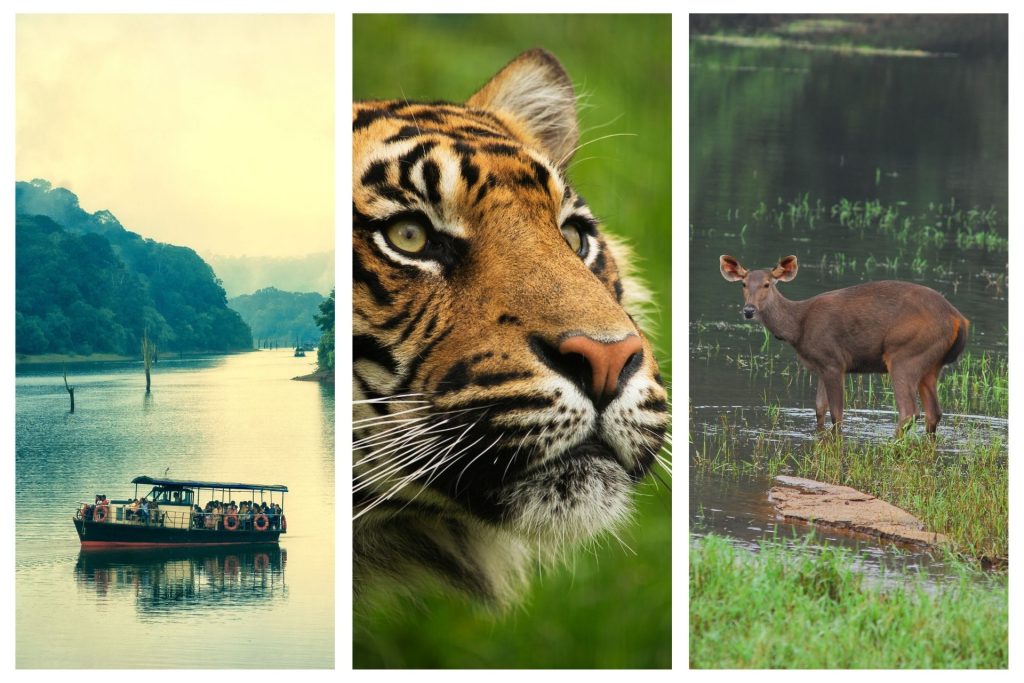
Breath-taking beauty coupled with astounding hidden glades, Periyar Tiger Reserve is a delight to visit. A protected area near Thekkady in the district of Idukki Kottayam and Pathanamthittha in Kerala, it is one of the most noteworthy elephant reserves and tiger reserves in the country.
#Trivia: It is often referred to as Thekkady as well. It was originally founded as Nelliyampathy Game Reserve by the Maharaja of Travancore in 1934. It was later declared as a National Park in the year 1950.
The park is made up of gorgeous tropical grasslands, deciduous forests and an absolutely stunning combination of rivers and lakes. It completes the ecosystem.
It comprises 35 tigers in all and is also famous for its Asian Elephants as well as a few white tigers.
Other than these, you can also come across a variety of other fauna such as sloth bears, Nilgiri Langur, lion-tailed macaque, Indian giant squirrel, jungle cat, sambal, cheetal, leopards, wild pig, gaurs, sambals, and a large diversity of reptiles, amphibians, fish, insects and birds.
An absolute bird-watching nibbana as well, Periyar Tiger Reserve is often dubbed as a photographer’s paradise.
#Trivia: This reserve is also home to South India’s largest butterfly Southern birdwing. It also houses the extremely threatened Travancore Evening Brown variety of butterfly.
If you truly want to enjoy your time at Periyar, visit it between October to May. Mild summers makes the conditions more conducive to spot an animal or tiger or two. If you like, you can also take a cruise on a boat in the Periyar Lake.
Exploring the Tiger Trail along with guides and forest department officials is an absolutely mind-blowing experience. You can not only spot tigers but also enjoy sightings of elephants, sambals, etc.
Entry Fee of Periyar Tiger Reserve
Entry fee to Periyar Tiger Reserve for Indians is INR 33 per Adult and 5 per Child. For Foreigners the fee is INR 450 per Adult and 155 per Child.. For those who wish to carry a Video Camera the fee is INR 300 and 38 for Still Camera.
Fee for Boat Safari at Periyar Tiger reserve is INR 150 per person above 11 years of age and INR 50 per person below 11 years.
Timings of Periyar Tiger Reserve
Periyar Tiger Reserve is open every day from 6:00 AM to 6:00 PM. Safari timings vary depending on the season and can be vetted with the forest department or while booking your stay at Thekkady.
5. Ranthambore Tiger Reserve
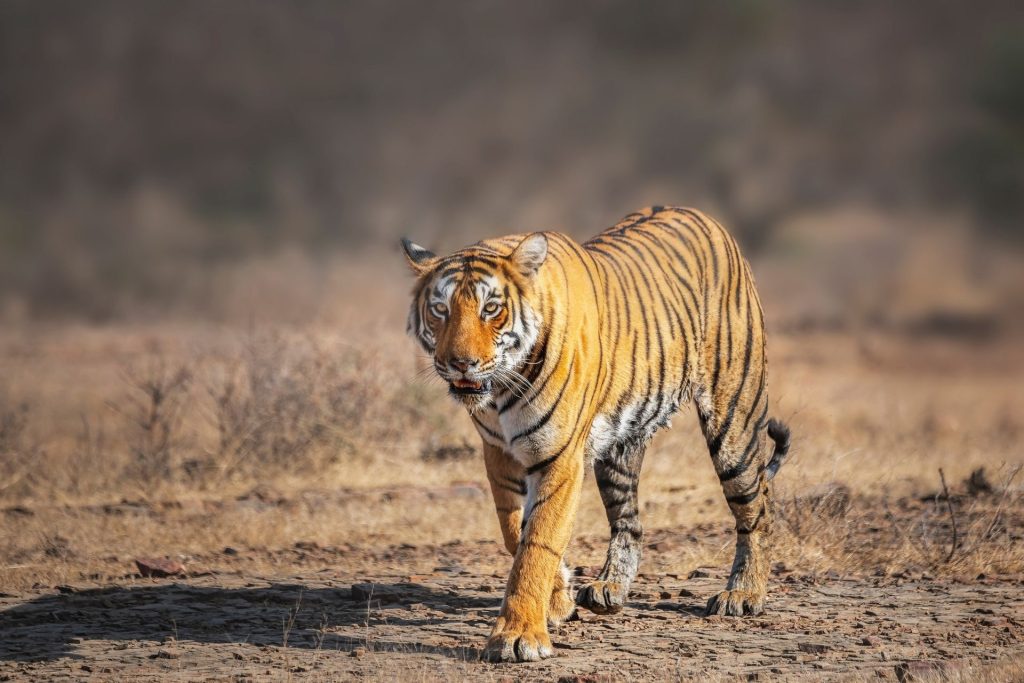
One of the most famous and biggest tiger reserves in Northern India, Ranthambore Tiger reserve, along with Kaila Devi Sanctuary and Mansingh Sanctuary forms a haven for tigers. It is believed to have a higher sighting rate as compared to other parks.
#Trivia: It was declared a national park in 1981 and a wildlife sanctuary way back in 1957.
There are believed to be more than 50 tigers living in the sanctuary, however, this needs to be confirmed by the authorities. The most famous tigers of Ranthambore are Ustad, Sundari, Sitara, Dollar, Mala, Bina 1 and Bina 2. Every tourist has a story to take back while touring Ranthambore and it’s time you shared yours.
Besides majestic tigers, you can also see jackals, Indian flying foxes, Chinkara, Toddy cat, marsh crocodiles, leopards, Nilgai, Sambar deer, striped hyenas, Hanuman langurs and much more. It is home to nearly 300 types of dry deciduous vegetation and over 270 types of birds and avifauna.
Timings of Ranthambore Tiger Reserve
The timings of the safari are quite varied and hence it is definitely advisable to check with the guides or tourist office for the same. Generally the morning safari takes place between 6am to 10am and evening safari between 2:30pm up to 7pm. Here is the detail breakup by season:
- Closed: During July to September
- During October: 7AM to 10.30AM and 2.30 PM to 6 PM
- November to January: 7AM to 10.30AM and 2 PM to 5.30 PM
- February to March: 6.30 AM to 10 AM and 2.30 PM to 6 PM
- 1st April to 15th May: 6 AM to 9.30 AM and 3 PM to 6.30 PM
- From 15th May to 30th June: 6 AM to 9.30 AM and 3.30 PM 7 PM
Safari Entry Fee at Ranthambore Tiger Reserve
You can indulge in a Canter safari or a Jeep safari as per your itinerary. However please note that Canter safaris are not available in zones 7-10.
- Gypsy Safari: INR 974 per person for Indians and 1,714 per person for foreigners. There is no fee for Kids under 5 yrs old. There are discounts for Indian students.
- Canter Safari: INR 617 per person for Indians and 1,357 per person for foreigners.
Price is inclusive of vehicle hire and guide fee of INR 539 (gypsy), and 422 (canter), for both Indians and foreign travellers. It also includes a safari vehicle fee of INR 134 (gypsy) and 19 (canter).
Come and witness the greatness of the wild only at Ranthambore in Sawai Madhopur District of Rajasthan.
6. Tadoba Andhari Tiger Reserve
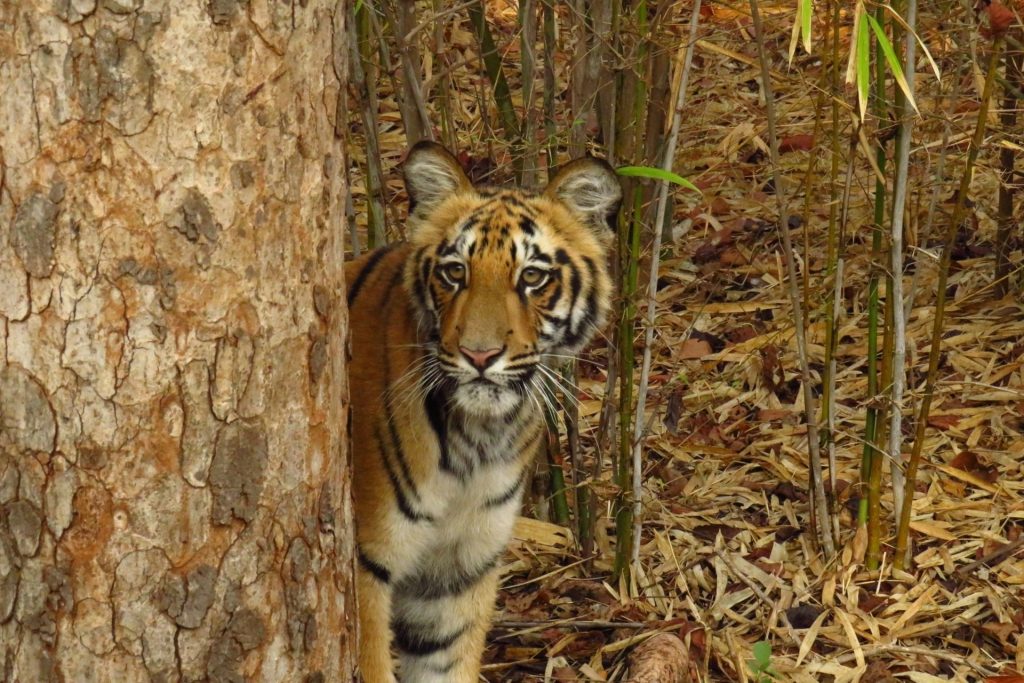
Decidedly the most popular and famous tourist spots of Maharashtra, Tadoba Andhari Tiger Reserve is said to be the most well-protected reserves of India. The reserve is known for its maximum visible tiger sightings. Located in the Chandrapur district of Maharashtra, Tadoba is a favourite tourist getaway for wildlife enthusiasts and avid photographers.
#Trivia: Tadoba is famous for its National park, tiger reserve, Tadoba lake, Erai dam amongst others.
It inhabits around 88 tigers and is considered to be one of the oldest and largest reserves of the country. You can not only spot tigers easily but also other wild animals like jungle cats, sloth bears, marsh crocodile, leopards, Indian Bison, sambar deer, barking deer, four-horned antelopes, hyenas, Indian mouse deer, wild dogs, etc. It is also home to over 200 varieties of birds and different types of flora.
The famous tigers of Tadoba are Maya (the Queen of Tadoba), Bajrangi, Choti Tara, Sitara (tigress), Sonam (Tigress), etc. These names are perhaps synonymous to Tadoba as you don’t say you saw a tiger but you say, ‘You saw Choti Tara or Sonam with her cubs or the queen of the land – Maya’.





Credits: Shivalingam Somu
Best Time to Visit Tadoba Andhari Tiger Reserve
The best time to spot the most tigers is between March to June however, the Tadoba Andhari Tiger Reserve remains open from October to June. It is advisable to book your tickets in advance to avoid last minute disappointments.
Safari Timings of Tadoba Andhari Tiger Reserve
Jeep safari is a great way to explore the expanse of Tadoba along with your folks. The timings of the safari at Tadoba Andhari Tiger Reserve are 6:00 AM to 10:00 AM and 3:00 PM to 6:00 PM.
Safari Entry Fee at Tadoba Andhari Tiger Reserve
The cost of Jeep / Gypsy safaris at Tadoba Andhari Tiger Reserve is a mix of four components: entry fee per vehicle (max 6 persons), vehicle hire, guide charges, and camera fee. Here is the detail breakup:
- Tiger Reserve Entry Fee: During weekdays INR 4,000 per vehicle for bookings made 120 to 60 days in advance, and INR 1,000 per vehicle for bookings made less than 60 days in advance. During weekends INR 8,000 per vehicle for bookings made 120 to 60 days in advance, and INR 2,000 for bookings made less than 60 days in advance. If opting for Tatkal, then the charges are INR 4,000 per vehicle for all days.
- Vehicle Hire: INR 2,700 for the core area and 2,200 rupees for the buffer area.
- Guide Fee: INR 350.
- Camera Fee: INR 200 for lenses up to 250 millimeters and INR 250 for lenses above 250 millimeters.
7. Kaziranga Tiger Reserve
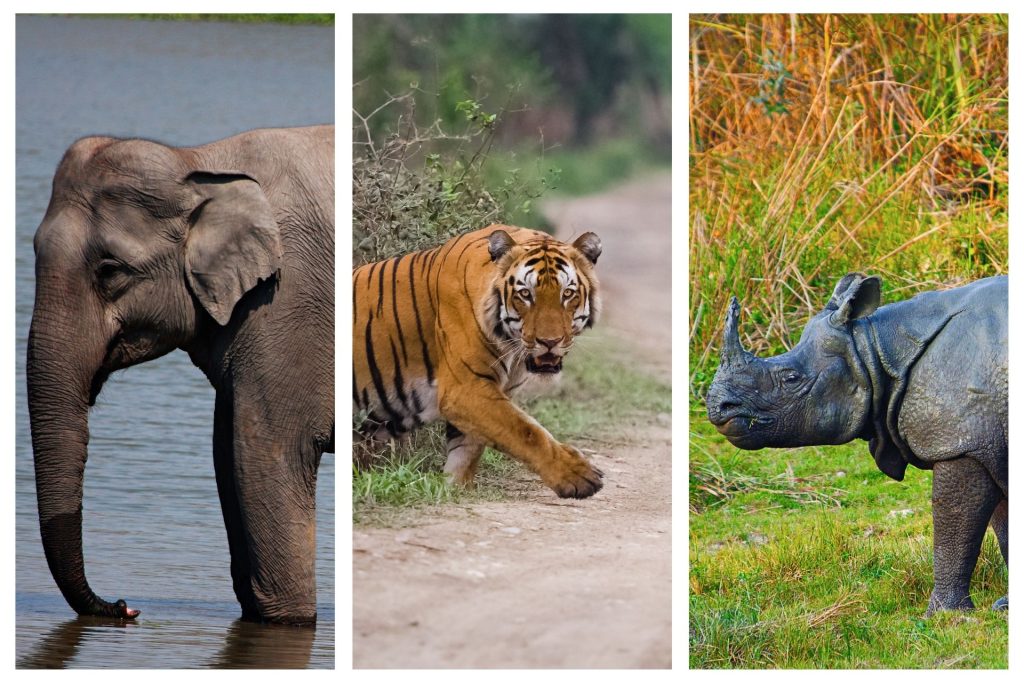
The Kaziranga National Park is one of the most gorgeous tiger reserves and national parks in the country located in Assam. Home to the rare and ingenious one-horned Rhinoceros, Kaziranga boasts of vast expanses of flora and fauna that encompasses the entirety of North-east India. Formed in 1908, this national park is a biodiversity hotspot.
#Trivia: It is home to nearly 2/3rd of the world’s one-horned rhinoceros population and currently houses approximately 2200 of the Indian one-horned rhinoceros. It was declared a World Heritage Site by UNESCO in 1985.
The enigmatic National Park is also home to varied species of avifauna and is considered as an important bird area by Birdlife International for their conservation.
There are approximately 104 tigers residing in the expansive realms of Kaziranga National Park and it was declared a tiger reserve in the year 2006.
Besides these charismatic creatures, you can also spot Leopards, Sloth Bears, Hoolock Gibbon, Wild water buffalo, swamp deer, amongst others.
Best Time to visit Kaziranga Tiger Reserve
November to April is the best time to visit Kaziranga Tiger Reserve. The park remains closed from 1st May to 31st October every year.
Safari Timings at Kaziranga Tiger Reserve
The park organizes Jeep and Elephant Safaris in Kaziranga Tiger Reserve to promote tourism and walk you through the natural habitats of God’s own creatures.
Elephant safari timing-
Elephant Safari timings at Kaziranga Tiger Reserve are from 5:30am to 6:30am and 6:30am to 7:30am.
Jeep Safari timing-
Jeep Safari timings at Kaziranga Tiger Reserve are from 8:00am to 10:00am in the morning and 2:00pm to 4:00pm in the afternoon.
You can enter from 4 zones categorized by the park authorities namely- Mihimukh in Central range at Kohora; Bagori in western range Bagori; Agaratoli in eastern range in Agaratoli and Ghorakhati in Burapahar range in Ghorakhati.
#Trivia: You can find ample number of tourist getaways around Kaziranga as well such as Hoollongapar Gibbon sanctuary, Orang National Park, Kakochang falls, Addabarie tea estate, amongst others.
Make your trip to Kaziranga tiger reserve worthwhile by booking your itinerary today!
8. Sunderban Tiger Reserve
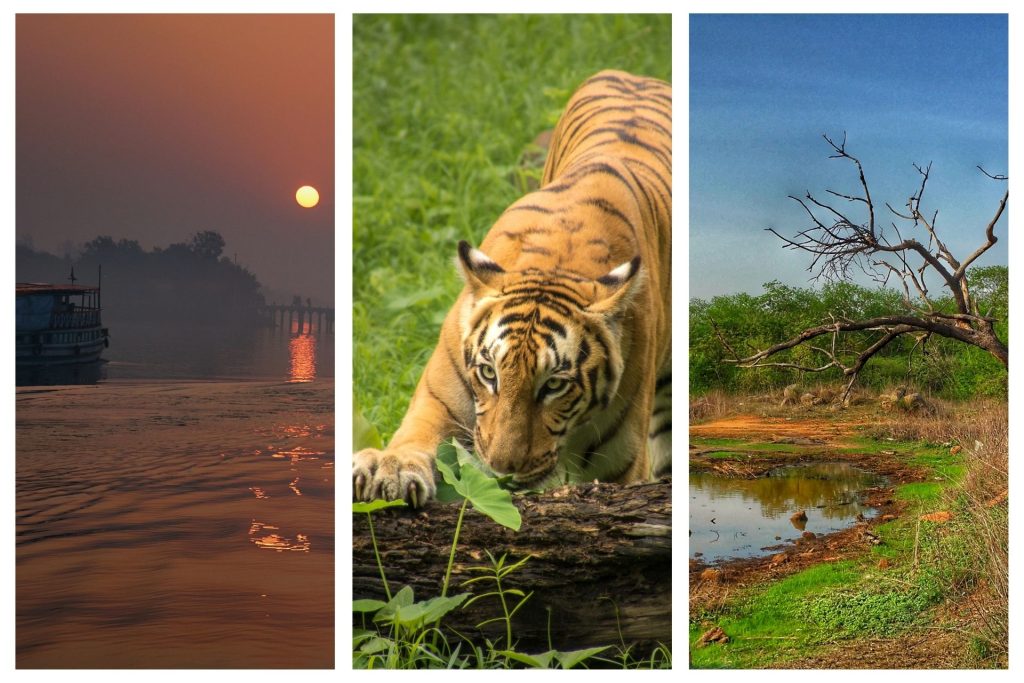
Welcome to the abode of the Royal Bengal Tigers!
The Sunderbans National Park and Tiger Reserve is probably the largest delta spread over 10,000 sq. kms. of India and Bangladesh. Its unique ecosystem is a natural wonder of South Asia and the world over.
Located in West Bengal, it is an important tiger habitat and biosphere reserve. There are a whopping 200 tigers in the Sunderbans (India and Bangladesh) and is probably the most unique experience for all people visiting the place.
#Trivia: It is named Sunderbans because of Sundari trees found in abundance in the area. Sunderbans is the only Mangrove forest in the world having the Tiger as its native population.
It was declared a UNESCO World Heritage Site in 1987. Sunderban was declared a wildlife sanctuary in 1977 and established as a renowned National Park in 1984. It was declared a Tiger Reserve in 1973 under Project Tiger.
A variety of flora and fauna captivates your senses while touring inside Sunderbans. It is home to famous reptiles such as rock python, king cobra, water monitor, as well as endangered river turtles called Batagur Baska.
#Trivia: The Indian Sundarbans forms the largest tiger reserve and National Park in India.
Another specialty of the land is that it harbours some globally threatened and quite rare animals including estuarine crocodile, fishing cats, snubfin dolphin, water monitor lizard, Gangetic dolphin, common otter, six species of ray and shark, hawksbill turtle, green sea turtle, amongst others.
It is home to nearly 250 species of birds, including a large number of migratory birds that visit the park during the winter months.
The only way to enjoy Sunderbans is by taking a Boat Safari as it is the only means of movement inside the park. There are primarily two types of boats available in Sunderbans – A.C and Non-A.C. and come in two sizes viz. small and large.
Boat Safari Timings at Sunderban Tiger Reserve
The boat service operates between 8:30am to 4:30pm every day at Sunderban Tiger Reserve.
Best Time to visit Sunderban Tiger Reserve
The best time to visit Sunderbans is between September to March.
Revel in the magic of the Sundarbans- One of the greatest wonders of India!
9. Buxa tiger reserve
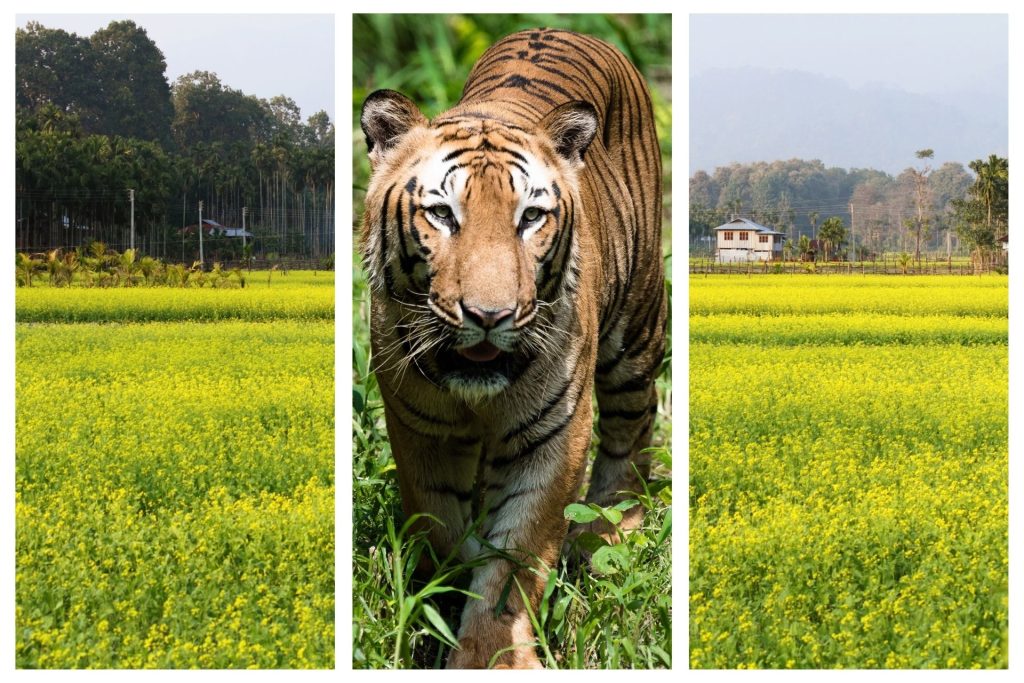
Set up on 16th February 1983, the Buxa Tiger Reserve forms an important part of the ecosystem on the north-eastern border of West Bengal in Rajabhatkhawa. It lies on the border of Assam and Bhutan.
#Trivia: It is the 15th tiger reserve of the country. Because of a large spread of rocky terrain, several parts of the reserve still remain inaccessible, even by forest authorities.
This colossal spread of Alluvial floodplains boasts of being the largest in the Dooars. It has a gorgeous landscape comprising a variety of flora and fauna.
The most distinct highlight of this tiger reserve is that it serves as an international corridor between India and Bhutan for the migration of Elephants. This is primarily because of the close proximity to the Phipsu Wildlife Sanctuary in Bhutan, lying adjacent to the northern part of the Buxa Tiger Reserve.
#Trivia: It comprises more than 8 types of forests and more than 200 species of unidentified avifauna.
The majestic Royal Bengal Tiger, in its full glory of blazing orange body and black stripes, can be seen roaming in the grasslands of Buxa that leaves tourists in absolute awe. You can also spot another member of the cat family, namely Clouded Leopard, which is usually shy of coming out in the open and quite difficult to spot and is a rare endemic species of this forest.
Besides this, you can also spot the gorgeous leopards, jungle cats, fishing cats, Chinese Pangolin, Regal Python, Asian elephant, Wild buffalo, Palm Civet, Malayan Giant Squirrel, small clawless otter, sambhars, chitals, and much more.
#Trivia: It is home to the monitor lizard, the deadliest of all lizards, along with 3 types of pythons and many species of tortoise.
The biggest highlight of the forest remains the inhabitation of forest tribes that comprise of Madesia, Garo, Rava, Mechia, Rajbanshi and Bhutia.
Safari Entry fee and timings at Buxa tiger reserve
Jeep safaris at Buxa tiger reserve start at 6am every day and evenings at 3pm. Each safari lasts for nearly 3 to 4 hours each. A jeep safari costs Rs. 800 approx. There is no entry fee to visit the Buxa tiger reserve.
Note: Buxa Tiger reserve is closed every year between 15th June to 15th September because of incessant rainfall plaguing the region.
Best Time to visit Buxa tiger reserve
The best time to visit the Buxa Tiger reserve is between October to April. If you are lucky in winters, you can also get to see many migratory birds, making it an absolute delight for all photographers.
10. Mudumalai Tiger Reserve
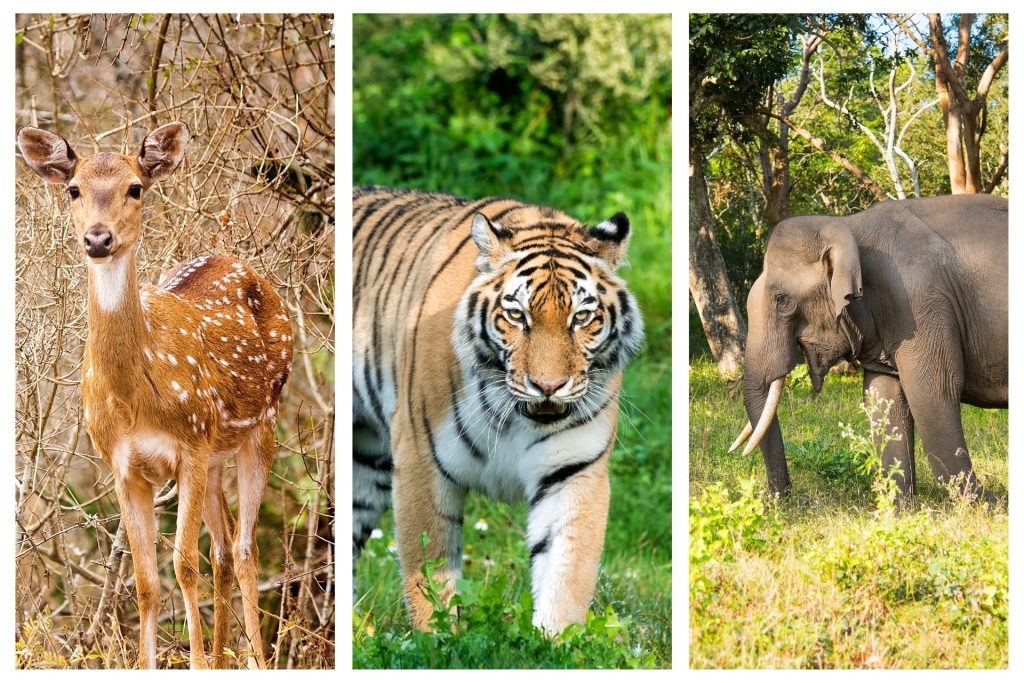
Get awestruck with the exotic wildlife of Mudumalai Tiger Reserve. Located in the Nilgiri District of Tamil Nadu, this gorgeous national park and tiger reserve is one of the most fascinating forests of the country.
Home to a number of endangered animals and birds, it boasts of an expansive landscape that can be seen distinctly while taking a tour through the sanctuary. It was declared a Tiger Reserve in 2007 to help save the dwindling population of Tigers in the country.
The river Moyar separates the Bandipur National Park from Mudumalai. The Grey Langur and Bonnet Macaque are the two major primates of this region.
#Trivia: The Nilgiri sub-cluster of 6000 sq. kms. of the Western Ghats, which includes the Mudumalai National Park, is being considered to be elevated to the status of a UNESCO World Heritage Site by the Committee.
The area comprises 44 to 80 tigers at the reserve who are absolutely free to roam the grassy lands of the forests. It is nothing less than a haven to be able to spot them while on a safari. They form the single largest population of this majestic species in India. (Nagarhole-Wayanad-Mudumalai) includes the Mudumalai tigers.
You can also spot other wild animals such as chitals, leopard cat, Indian wild dog, golden jackal, red giant squirrel, and an excellent spread of avifauna, amphibians, etc. You can enjoy a Canter safari, Elephant safari as well as a Jeep Safari through the forests of Mudumalai.
Entry Fee of Mudumalai Tiger Reserve
The entry fee at Mudumalai Tiger Reserve is Rs. 15 only.
Entry Timing of Mudumalai Tiger Reserve
The Mudumalai Tiger Reserve is open from 6am to 6pm every day for safari tours.
Safari Entry fee and Timings at Mudumalai Tiger Reserve
A jeep safari at Mudumalai Tiger Reserve typically costs Rs. 1500 for an hour; Rs. 100 per person for the Elephant safari; Rs. 45 per person for a van or canter safari.
The timings for the Jeep safari are dependent on the availability of the jeep and driver. It is best to book it in advance with the Jungle authorities. The safari lasts for around 2 to 3 hours on an average.
The van safari lasts for around 30 minutes and can be taken from 6:30am to 9am in the morning and 3:30pm to 6pm in the evening.
The elephant safari lasts from 7am to 8:30am in the morning and 3:30pm to 5pm in the evenings. It also lasts for approx. 30 minutes.
Put on your sunscreen and get ready for a jungle treat with wild animals and glories fauna to keep you company right here!
#Didyouknow: Madhya Pradesh has the highest number of tigers, nearly 526, followed by Karnataka (524), Uttarakhand (442), Tamil Nadu (229), Maharashtra (190), Assam (167), Kerala (136) and Uttar Pradesh (117).
11. Nagarjunasagar-Srisailam Tiger Reserve
Nagarjunasagar – Srisailam tiger reserve is the largest tiger reserve in India. It is spread over 5 districts and is considered to be a safe haven for these wild cats. This tiger reserve is also known as Srisailam Wildlife Sanctuary and is located in Srisailam, Andhra Pradesh.
It received the title of a tiger reserve in the year 1978 under Project Tiger. This reserve was renamed as Rajiv Gandhi Wildlife Sanctuary in 1992. There are around 70 tigers residing in the premise of Nagarjunasagar – Srisailam Tiger Reserve and is also home to different species of wild animals such as sloth bear, blackbuck, Indian leopard, mugger crocodile, chevrotain, dhol, chital, sambar deer, etc.
Jeep safari is the best way to get around the park and enjoy the flora and fauna. You can hire jeeps for a safari outside the park as there are no direct tours provided by the park itself.
Best Time to visit Nagarjunasagar-Srisailam Tiger Reserve
The best time to visit the Nagarjunasagar-Srisailam Tiger reserve is between October to March.
The safaris need to be coordinated with the park authorities and the local tour guides. It is best to speak with the resort you are staying at or the local tour guides to help you choose the best time to visit the park.
Entry Timings of Nagarjunasagar-Srisailam Tiger Reserve
The Nagarjunasagar-Srisailam Tiger Reserve is open from 7am to 5pm every day.
Get your lenses ready and capture the majestic Tiger in all its charm right here!
12. Pench Tiger Reserve
The Pench National Park or Pench Tiger Reserve is one of the most important tiger reserves of the country. The scenic beauty of the forest coupled with the spread of grasslands, waterfalls and rocky terrain is an absolute sight to behold. Pench National Park is the most intriguing highlight of the states – Madhya Pradesh and Maharashtra.
#Trivia- The fictional setting of the Jungle Book and the Second Jungle Book written by Rudyard Kipling are said to be set in this region.
The number of tigers as on date in Pench National Park is close to 53. Along with this majestic species, you can also spot the wild boar, chital, Nilgai, jackal, Indian wild dog, sambar, gaur, deer, wolf, langur, bison and much more. The park comprises more than 200 species of birds out of which 170 or more are migratory birds.
#Trivia: Pench was declared a sanctuary in 1965 and rose to the status of a National Park in 1975.
This place is a paradise for nature lovers, avid wildlife photographers and flora enthusiasts. The accessibility from Maharashtra and Madhya Pradesh makes this reserve a great way to explore the natural habitat of some spectacular species of animals.
You can enter the forest from designated zones in Madhya Pradesh comprising Karmajhiri Zone, Turia zone, Jamtara zone, and Rukhad zone. Maharashtra zones consist of Sillari zone and Khursapar zone.
Safari Timings at Pench Tiger Reserve
The morning safari at Pench Tiger Reserve takes place between 5:30am to 10:30am, afternoon safari takes place between 2:30pm to 6:30pm and the night safari is between 5:30pm to 8:30pm.
Get your dose of wildlife and much more at Pench National Park!
13. Bandhavgarh Tiger Reserve
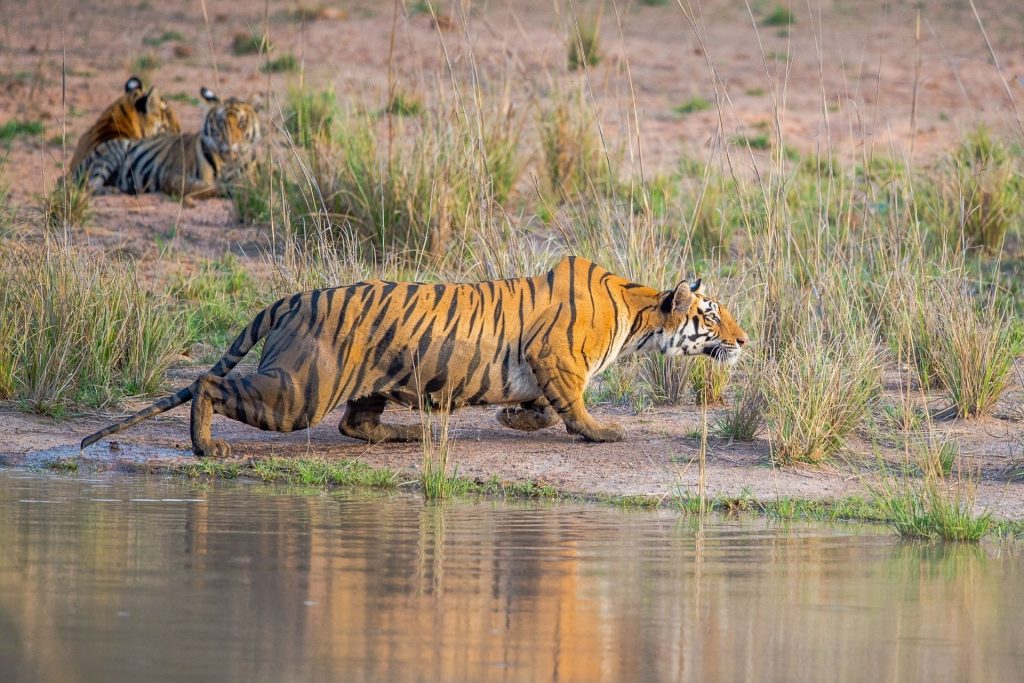
Bandhavgarh National Park is spread across Vindhya hills in Umaria district of Madhya Pradesh. It is the most famous location to spot White Tigers in India and is probably the highest known density of Tigers in the country.
There are around 50 tigers in the expansive 105 sq. kms. of forest area. It was declared a National Park in 1968. This tiger reserve is home to varied fauna such as sambar, nilgai, wild boar, chinkara, gaur, leopards, Bengal fox, spotted deer and much more. Bandhavgarh also houses over 250 species of avifauna.
The park is divided into 3 zones mainly Tala (gate 1), Maghdi (gate 2) and Khitauli (gate 3) and can be best enjoyed in a Jeep safari that can take up to 6 people at one time.
Best Time to visit Bandhavgarh Tiger Reserve
The best time to visit Bandhavgarh Tiger Reserve is from October to May.
Safari Timings at Bandhavgarh Tiger Reserve
The safari at Bandhavgarh Tiger Reserve is further divided into different timelines depending on the period you are visiting-
15th Oct to 15th Feb- 6:30am to 11am and 2:30pm to 5:30pm.
16th Feb to 31st Mar- 6am to 11am and 3pm to 6pm.
1st Apr to 30th June- 5:30am to 10am and 4pm to 7pm.
If you are looking forward to enjoying nature up close and personal, you can also indulge in an Elephant safari that has to be pre-approved by the park authorities.
Get a glimpse of nature’s majestic creatures walking the land only at Bandhavgarh.
14. Anamalai Tiger Reserve
Anamalai Tiger Reserve or Indira Gandhi Wildlife Sanctuary and National Park is located in Anaimalai hills in Tiruppur District, Tamil Nadu. Breath-taking views and a gorgeous spread of lush green escapades adds to the charm of this tiger reserve.
It was officially declared a tiger reserve in 2007.
#Trivia: It was officially established in the year 1848 and is one of the oldest national parks in the country.
The rich biodiversity of the park attracts thousands of visitors every year. There are nearly 30 elusive tigers living in the reserve along with other wild beasts such as leopards, lion-tailed macaques, spotted deer and elephants, crocodiles, peacocks and much more.
A photographer’s paradise, ATR prods the photographer’s mind for more. You can view nearly 70 species of fishes and amphibians, over 120 varieties of reptiles, 80 species of mammals, over 300 types of birds, more than 39 RED endangered and threatened species of plants, and much more.
Best Time to visit Anamalai Tiger Reserve
Anamalai Tiger Reserve is open to visitors all year round however the best time to visit is between June and February.
Timings of Anamalai Tiger Reserve
Anamalai Tiger Reserve opens at 6am and closes at 6pm. You can indulge in canter safaris or jeep safaris or even elephant safaris, depending on the availability.
Entry fees of Anamalai Tiger Reserve
The entry fee at Anamalai Tiger Reserve is between Rs. 5 to Rs. 30 for Indians and Rs. 50 to Rs. 300 for Foreigners. If you wish to carry your camera inside, then the fee is Rs. 50 for Still Camera and Rs. 30 for Handy Cam or Video Camera.
Elephant Safari charges at Anamalai Tiger Reserve
If you wish to go on an Elephant ride at Anamalai Tiger Reserve, the charge is Rs. 600 with a maximum of up to 4 people.
For more information, you can connect with the park officials to help you better.
15. Parambikulam Tiger Reserve
Welcome to Parambikulam Tiger Reserve located in Palakkad, Kerala. Popular for its safaris and jungle treks, the frenzy of gorgeous rivers and beautiful waterfalls, makes this place a haven for photographers and wildlife enthusiasts. It is blessed with peninsular vegetation and a great way to connect with nature.
Some of the most inclusive animals here are Travancore Kukri snakes, Indian leopards, lion-tailed macaques, King Cobra, flying lizard, wild boars, etc.
#Trivia: There are approx. 35 or more tigers living in the vast expanse of Parambikulam.
It came into existence officially in 1973, after the merger of the teak plantation and wildlife sanctuary. You can regale in different types of trekking expeditions along with a tourist guide that can vary from Elephant song trail to pugmark trekking trail or bear path trekking trail.
Best Time to visit Parambikulam Tiger Reserve
The Parambikulam Tiger Reserve can be enjoyed best between October to March where people can actually spot different animals.
Timings of Parambikulam Tiger Reserve
The Parambikulam Tiger Reserve remains open on all days from 7am to 6pm.
Entry Fees at Parambikulam Tiger Reserve
Each trek has a different rate specified for Indian nationals and foreigners. The general fee for different trekking trails can start at Rs. 1200 per head and go up to Rs. 6100 per head.
General entry fees at Parambikulam Tiger Reserve are between Rs. 50 to Rs 200 and can be best found out at the park office.
Welcome to Nature’s own Abode only at Parambikulam.
16. Kanha Tiger Reserve
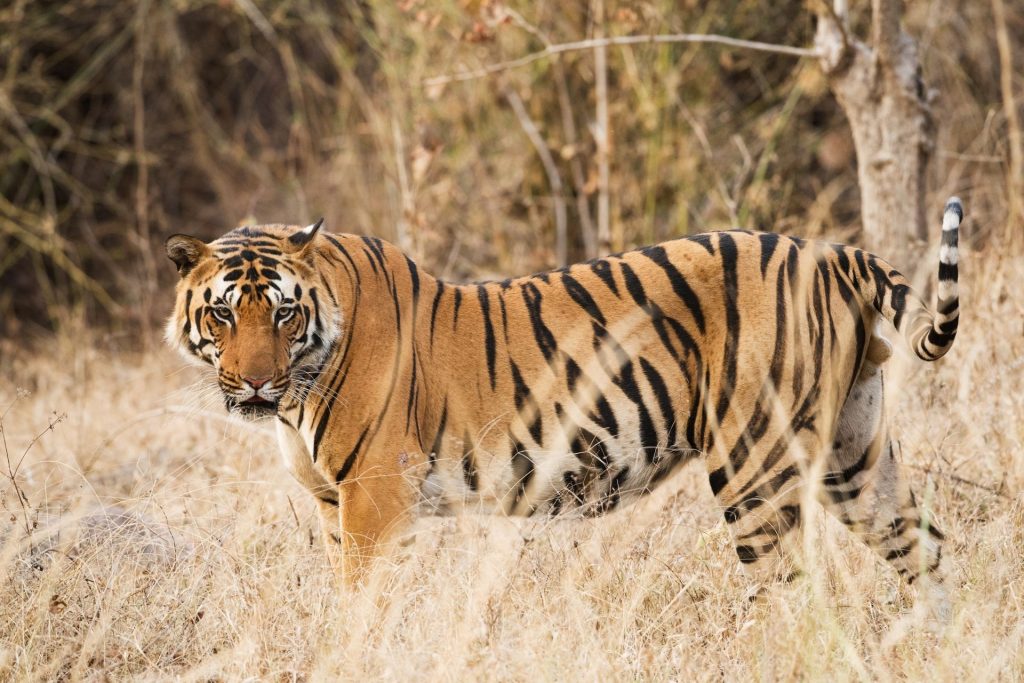
Ranked as one of the best national parks in Asia, the Kanha Tiger Reserve and National park is an impeccable tourist destination in Madhya Pradesh. The largest park in Central India, it is home to diverse flora and fauna.
Officially established in 1955, Kanha National Park is said to be the setting of Rudyard Kipling’s – the Jungle Book.
#Trivia: It houses the rare and unique deer species – the Barasingha.
It is home to different animals including wild dogs, pythons, wild cats, foxes, hyenas, leopards, jackals, etc.
There are approx.. over 65 tigers said to roam around freely in the expansive forests of Kanha, making it a haven for all wildlife enthusiasts to capture a picture or see one at a distance.
Best time to visit Kanha Tiger Reserve
Kanha Tiger Reserve is best enjoyed between October to April when the weather is pleasant to explore the jungle.
Safari Entry Fee and Timings at Kanha Tiger Reserve
There are a lot of jeep safaris available within the premise of Kanha Tiger Reserve with distinct timelines- 6am to 11am and 3pm to 6pm. On an average the safari will cost you anywhere between Rs. 1000 to Rs. 2000 for a full jeep.
You can also enjoy an elephant safari at Kanha Tiger Reserve that may cost you Rs. 300 to Rs. 600 per head.
Be one with nature only at Kanha.
17. Nagarhole Tiger Reserve
Located in the Kodagu District of Karnataka, Nagarhole National Park is also known as Rajiv Gandhi National Park. With an astounding population of over 90 tigers roaming freely in the premises of the park, Nagarhole is a wildlife enthusiast’s dream come true.
It forms a part of the Nilgiri Biosphere reserve and can be seen with an expansive vegetation, flora and fauna spread over acres of land. The park comprises a rich forest green cover, small streams, waterfalls, valleys and much more.
The fauna of the park includes different wild animals such as leopards, Gaur, Elephants, chital and sambar deer, striped hyena, wild boar, Ussuri dhole, four-horned antelope and much more. It is also home to over 270 species of avifauna, different reptiles and mammals along with a vast insect biodiversity.
Safari Entry Fee and Timings at Nagarhole Tiger Reserve
A jeep safari at Nagarhole Tiger Reserve is the most preferred way of moving around the forest. The timings are generally between 6am to 8am and evening 3pm to 5pm. The entry fee at Nagarhole Tiger Reserve depends on the forest regulations and differs for Indians and Foreigners.
If you have a tiger to spot, Nagarhole is the place to be!
18. Bor Wildlife sanctuary
The smallest tiger reserve in India is the Bor Wildlife Sanctuary. It is said to house around 5 tigers only and is the 47th tiger reserve of the country. It is located in Wardha district of Maharashtra and falls in the crucial location between Tadoba-Andhari and Pench tiger reserves, located in Chandrapur and Nagpur districts respectively.
#Trivia: It was declared a tiger reserve in 2014. It is centrally located among other tiger habitats namely Nagzira Navegaon tiger reserve, Melghat tiger reserve, Satpura tiger reserve and Umred Karhandla wildlife sanctuary.
You can spot the barking deer, Indian leopard, mouse deer, wild boar, Indian bison, amongst other faunal species here. There are more than 150 types of birds residing in the park as well. Six endangered reptile families are also seen residing here viz. Indian rock python, Indian rat snake, Russel Viper, Indian Cobra, Chequered keelback, and Monitor lizard.
19. Panna Tiger reserve
Bestowed with the Award of Excellence in 2007 as the best maintained national park in India, Panna Tiger Reserve is one of the smallest national parks in the country. With approx.. 30 tigers residing in the national park, there is said to be a fluctuating population problem of tigers in the vicinity.
#Trivia: It was declared a national park in 1981 and a tiger reserve in 1994 and is the 22nd tiger reserve of the country.
The park is home to Nilgai, sambar deer, jackals, chital, chinkara, hyena, wild cats, etc. along with over 200 types of avifauna.
The Panna Tiger reserve is open for visitors from 16th Oct to 30th June, however, it depends on the park authorities based on the weather conditions. You can enjoy a boat ride through the water body to spot the water predators and enjoy elephant rides in the morning, along with the option of jeep safari.
Entry Fees at Panna Tiger reserve
Entry fees at Panna Tiger reserve for Indians is Rs. 40 per person and Rs. 500 per person for Foreigners. Carrying a camera will cost you approx.. Rs. 40 and video recorder Rs. 200.
Boat ride at Panna Tiger reserve costs Rs. 150 per person for Indians and Foreigners.
Timings of Panna Tiger reserve
Entry timings to the Panna Tiger reserve are from 6am to 10:30am and 2:30pm to 5:30pm.
Safari Entry Fee at Panna Tiger reserve
Jeep safari at Panna Tiger reserve costs around Rs. 1500 for half day.
Elephant safari at Panna Tiger reserve costs Rs. 100 per person for Indians and Rs. 600 per person for Foreigners.
Night Safari at Panna Tiger reserve is priced at Rs. 1800 per jeep.
20. Satpura Tiger Reserve
Satpura is a quaint park located in the Hoshangabad district of Madhya Pradesh. Established in the year 1981, it is home to a variety of wild animals such as the Blackbuck, Leopard, Ussuri Dhole, Indian Gaur, Sloth Bear, and much more.
#Trivia: Satpura is a congregation of 7 mountains that start from Maharashtra, crossing over Madhya Pradesh and finally terminating at Chhattisgarh. The Satpura range is heavily forested and is home to many national parks.
It covers a huge mass by combining the Bori Wildlife sanctuary and Pachmarhi wildlife sanctuary. This tiger reserve got included under Project Tiger in 1999 and became known as Bodi-Satpura Tiger Reserve. It was awarded the TOFT Wildlife Tourism Award in 2010 as the most visitor-friendly wildlife destination. As compared to other wildlife sanctuaries, Satpura is relatively less-crowded where one can hear the sounds of nature resonating through the spaces.
#Trivia: It was first explored by Captain James Forsyth of Bengal lancers in 1862 and was declared the first reserve forest of India.
There are over 300 species of birds, 52 species of mammals and 30 species of reptiles that are found in the vast expanse of Satpura National Park. The number of tigers in the forest are yet undisclosed but is said to be a great place to spend some quality time with family and friends.
Safari Timings at Satpura Tiger Reserve
The Satpura Tiger Reserve remains open from November to May. The safari timings in winter are from 6:30am to 10:30am and 2:30pm to 5:30pm; summer timings are from 5:45am to 9:30am and 3pm to 6:30pm.
Safari Entry fee at Satpura Tiger Reserve
The safari at Satpura Tiger Reserve is priced at Rs. 3800 approx. for Indians and Rs. 5800 approx. for Foreigners. Elephant safari in the buffer zone is priced at Rs. 600 per person and canoeing down the Denwa river to Tawa reservoir is priced at Rs. 1000 per person approx..
#Didyouknow- There are 50 tiger reserves in India and is home to more than 70% of the tiger population of tigers in the world! As per the census carried out in 2018, there are approximately 2967 tigers living in India.
21. Dandeli – Anshi Tiger Reserve
Dandeli National Park is located in Karnataka. Along with its neighbouring Anshi national park, it was declared a part of Anshi-Dandeli Tiger Reserve in the year 2006. It was also notified as a Dandeli Elephant reserve under Project Elephant in 2015. It was renamed as Kali Tiger Reserve in 2015.
#Trivia: It is the 2nd elephant reserve in Karnataka after Mysuru Elephant reserve that was declared one in 2002.
It is a haven for birdwatchers and photography enthusiasts because of the openness of the park and a trip down the river Kali. It houses around 200 species of birds.
#Trivia: It is the only Tiger Reserve in India to report frequent sightings of the Black Panther!
There are a total of 13 tigers supposedly residing in Dandeli-Anshi Tiger Reserve. Even if it gets a little difficult to spot the tigers in Kali Tiger Reserve, it is much easier to see other species of wild animals viz. elephants, mouse deer, leopard cat, Indian bison, grey slender loris, flying squirrel, etc.
Entry Fee of Crocodile Park at Dandeli – Anshi Tiger Reserve
Tourists can also enjoy viewing the Crocodile park located in the premise of Kali Tiger Reserve at a nominal fee of Rs. 20 per person approx.. If you are lucky, you can spot the crocs in their natural habitat basking in the sun or lying around lazily in the water.
Safari Entry Fee and Timings at Dandeli – Anshi Tiger Reserve
Tourists can enjoy river rafting in the Kali river or Jeep safari within the Kali Tiger Reserve at Rs. 450 per person approx.. The park safari remains operational between 6am to 8am and 4pm to 6pm every day.
Get your trekking and water sport gears ready and visit Kali Tiger Reserve or Dandeli-Anshi Tiger Reserve today!
22. Nagzira Tiger Reserve
Notified as the 46th Tiger reserve in India and the 5th in Maharashtra, Navegaon-Nagzira Tiger Reserve is located in the Bhandara and Gondia districts of Maharashtra. The park is home to different types of flora and fauna such as Indian gaur, tigers, nilgai, chital, wild boar, barking deer, sloth bear, mouse deer, wild dog, etc.
It houses more than 160 species of birds, 34 species of mammals, 36 species of reptiles and around 4 amphibians. The Nagzira Tiger reserve is said to have around 20 tigers residing here, as per official reports.
Best Time to visit Nagzira Tiger Reserve
The best time to visit the Navegaon-Nagzira Tiger Reserve (NNTR) is between October to May.
Safari Entry Fee and Timings at Nagzira Tiger Reserve
The safari at Nagzira Tiger Reserve takes place between 6am to 10am and 2pm to 6pm. The entry fees range between Rs. 20 to Rs. 50 for Indians and guide fees is approx.. Rs. 200.
23. Melghat Tiger Reserve
Among the first 9 tiger reserves to be notified under Project Tiger in 1974, Melghat Tiger Reserve is located in the Amravati district of Maharashtra. It is said to house over 40 tigers and is home to different types of flora and fauna.
It was declared as Melghat Wildlife Sanctuary in 1985. This tiger reserve is also home to different wild animals such as Sloth Bear, Jackal, Caracal, Ratel, Chinkara, Blue bull, Wild Dog, different types of deer, porcupine, rhesus monkey, and much more. The endangered and ‘back from extinction’ Forest Owlet is also seen in different locations of Melghat.
It is home to over 260 species of birds, 80 species of mammals, 90 species of fish, etc.
Entry Fee at Melghat Tiger Reserve
Tourists can visit the Melghat Tiger Reserve from December to June and enjoy the safari organized by the forest department. The entry fees to visit Melghat Tiger Reserve vary from Rs. 15 to Rs. 60 for Indians or Foreigners.
#Trivia: It is one of the oldest tiger reserves of India.
Come and regale in the sounds of nature only at Melghat, Maharashtra!
24. Manas Tiger Reserve
Manas National Park or Wildlife Sanctuary is located at the foothills of Himalayas-Bhutan in the state of Assam and is a UNESCO World Heritage Site, a Project Tiger reserve, a biosphere reserve and an elephant reserve. Phew! With such an elaborate list of specifications, the Royal Manas National park is home to endemic wildlife that is not found anywhere in the world like Assam Roofed Turtle, Golden Langur, Pygmy Hog, and Hispid Hare. It is also famous for its population of the water wild buffalo.
The reserve is rich in fauna that holds more than 450 species of birds, 55 recorded species of mammals, 3 species of amphibians and 50 reptiles.
#Trivia: Manas Wildlife Sanctuary was inscribed as a World Heritage Site in 1985 and is one of the first reserves to be included under Project Tiger in 1973.
There are nearly 60 tigers residing in the vicinity of Manas Tiger Reserve, as per reports. Manas is probably the site of what earth looked like before being inhabited by man.
Best Time to visit Manas Tiger Reserve
The best time to visit Manas Tiger Reserve is between November to April. You need to obtain permits to enter the forest area and can be obtained by the Forest department. Private jeep tours are the most reliable to explore the sanctuary as the department does not provide any jeep or guides.
Entry fees at Manas Tiger Reserve
For Indians, the entry fee at Manas Tiger Reserve is approx. Rs. 50 per person for half day and Rs. 200 per person for full day. For Foreigners, the fee is Rs. 500 per person for half day and Rs. 2000 per person for full day.
Photography is a must try at the Manas Tiger Reserve and the charges include Rs. 50 for Indians, Rs. 500 for foreigners; Videography is priced at Rs. 500 for Indians and Rs. 1000 for foreigners.
Safari Entry Fee and timings at Manas Tiger Reserve
The Safari timings at Manas Tiger Reserve are from 9am to 12pm and 2pm to 5pm every day.
Jeep Safaris can be hired at Rs. 3000 for 4 people half day; Rs. 5000 for 4 people full day.
Elephant safari Manas Tiger Reserve is priced at Rs. 500 for Indians and Rs. 1550 for foreigners. The timings for the same are 6am and 7am only. Morning safaris are the best way to explore the flora and fauna of the park.
Try river rafting over the 35-km stretch of azure waters that will transcend you into a different world altogether. With an excellent stretch of green escapades, Manas Tiger Reserve promises to be a delight for all those visiting it.
25. Sathyamangalam Tiger Reserve
Welcome to the largest wildlife sanctuary of Tamil Nadu- Sathyamangalam Tiger Reserve.
With diverse flora and fauna, Sathyamangalam Tiger Reserve is heaven on earth comprising different types of mammals, reptiles, birds and wild animals. The park is noted for the presence of Blackbuck, Four horned antelope, gaurs, elephants, leopard, hyena, wild dog, deers, civets, and much more.
The critically endangered Indian Vulture along with three other species of vultures were discovered to be thriving in Moyar River valley in Sathyamangalam Tiger Reserve.
With proper conservation efforts, there are around 50 or more tigers in the vicinity of the reserve. Established in 2008, it was declared a tiger reserve in 2013.
#Trivia: It has received the award for the best managed tiger reserve from the Union ministry of environment, forest and climate change.
Best Time to visit Sathyamangalam Tiger Reserve
July to November is the best season to visit Sathyamangalam Tiger Reserve and can be explored in a Jeep safari.
Safari Timings at Sathyamangalam Tiger Reserve
The jeep safari at Sathyamangalam Tiger Reserve takes place between 7:30am to 11am and 3pm to 6pm. Visitors are requested to reach 30 minutes prior to the safari.
Connect with nature and wilderness only at Sathyamangalam National Park.
26. Dudhwa Tiger Reserve
The Dudhwa Tiger Reserve is located in Uttar Pradesh and comprises Kishanpur Wildlife Sanctuary, Dudhwa National Park and Katarniaghat Wildlife Sanctuary. The park is said to be home to nearly 90+ tigers residing harmoniously in their natural habitat.
While touring the park, you can also experience sightings of rhinoceros, swamp deer, elephants, hog deer, sambar, cheetal, etc. It was established as a National Park in 1977 and was declared as a Tiger Reserve in 1987. It falls under the Terai belt in the sub-Himalayan region and is known to be the most endangered ecosystems in the world.
#Trivia: The park is located very close to the border of Nepal.
Entry Fee at Dudhwa Tiger Reserve
Dudhwa Tiger Reserve is open for visitors from 15th November to 15th June. The entry fee is Rs. 50 per person approximately.
Safari Entry Fee and Timings at Dudhwa Tiger Reserve
Jeep safari timings at Dudhwa Tiger Reserve are from 7am to 10am and 3pm to 6pm every day. and the fee is Rs. 100 for jeeps. Safaris can be coordinated with the help of the forest department or private tour operators in the vicinity.
The park spells an enchanting list of over 400 avifauna along with migratory and exotic birds.
Experience the magical sight of nature converging with the wild only at Dudhwa National park.
When we talk about tiger reserves and natural habitats, certain other parks come to the forefront as well. This includes Pilibhit National Park, Pakke tiger reserve, Amrabad tiger reserve, Similipal Tiger reserve, Valmiki Tiger Reserve, Bhadra Tiger reserve, Rajaji tiger reserve, Mukundra tiger reserve, Achanakmar tiger reserve, Indravati tiger reserve and much more.
#DidYouKnow:
- The latest tiger reserve of India is Kamlang Tiger Reserve located in Arunachal Pradesh. With a staggering population of nearly 17 tigers living in the vicinity.
- Orang Tiger reserve is the 49th tiger reserve of the country and has the highest density of tigers in any reserve with nearly 28 big cats located in a small vicinity of the park.
- Palamau Tiger Reserve is one of the first original 9 reserves of the country and the only one in Jharkhand.
Bespoke beauty along with unprecedented wilderness and wild animals prancing about, these top 26 tiger reserves in the country are set to blow your mind away! Get your cameras prepped and take the journey of your life at these amazing National Parks and Tiger Reserves of India.
Book your holiday today!

